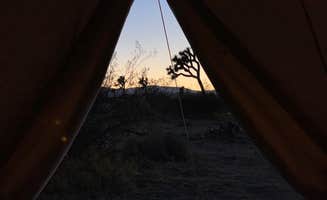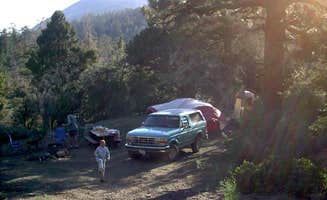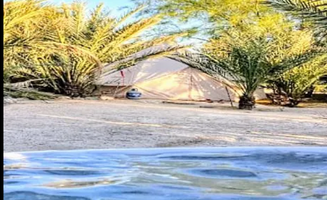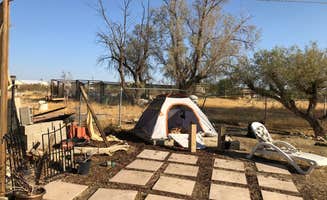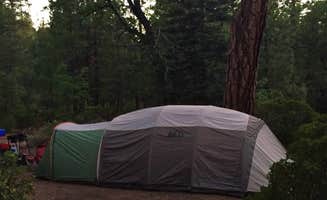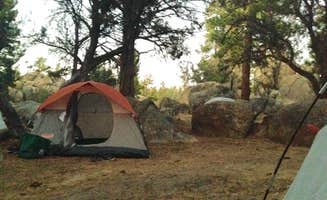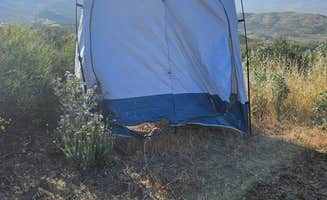Tent camping near Pioneertown, California offers diverse terrain ranging from high desert landscapes at 4,000 feet elevation to pine-covered mountain campsites exceeding 7,000 feet. The region experiences dramatic temperature fluctuations with summer days reaching 100°F while nights can drop below 50°F. Desert camping areas typically feature Joshua trees and yucca plants, while higher elevation sites in the San Bernardino Mountains provide pine forest cover and seasonal creek access.
What to do
Rock climbing access: Holcomb Valley Climbers Camp provides free dispersed camping with direct access to climbing routes. As one camper notes, "It is a free campground, first come first serve... This area is used almost exclusively by rock climbers, but anyone is welcomed. As long as you follow the guidelines for the area, you can set up your tent anywhere you see a spot" (Holcomb Valley Climbers Camp).
Gold panning: Search for gold along Holcomb Creek near camp, though be respectful of active claims. One visitor explains, "If you're into panning for gold you just might find some along Holcomb Creek. There are active claims in the area so be respectful" (Holcomb Valley Climbers Camp).
Trail exploration: Access trailheads directly from several camping areas. At Yucaipa Regional Park, campers appreciate "access to Zanja Peak Trail head" plus "3 lakes for fishing, water park during the summer, and friendly helpful staff."
Stargazing: The lack of light pollution makes this area exceptional for night sky viewing. Drive to more remote yellow post sites for optimal viewing conditions. A camper at Yellow Post #54 notes, "It is up on the ridge so lots of solitude and views."
What campers like
Solitude and privacy: Remote sites provide significant separation from other campers. At Desert Rose, one camper reports they "decided the next day to go a little further in the woods where you're no longer in the campground base. So this is called wild camping. And that was amazing not a single sound far from everybody, off the grid."
Accessible backcountry: Several areas offer backcountry camping experiences without difficult hikes. At Dry Lake Backpacking Campground, a camper shares, "We camped here on our way to summiting San G (as we lovingly call it)... We got to the camping area and it's tucked in the woods so there's lots of nooks and crannies even though it's a primitive open group camping area."
Wildlife viewing: The diverse ecosystems support various wildlife species. Campers regularly spot desert tortoises, jackrabbits, coyotes, and numerous bird species.
Horse-friendly options: Equestrians can find specialized camping facilities. At Black Rock Equestrian Campground, one visitor describes it as a "Huge open horse camp with 10 corrals, picnic tables, bbqs and fire rings, pick your spot anywhere you like. Almost all sloped but not awful. Lot gets regularly graded."
What you should know
High clearance vehicles required: Many tent camping areas require navigating rough roads. At Yellow Post #54, a visitor warns, "You will earn this spot as the drive from Hwy 38 is long and rocky."
Extreme temperature changes: Pack for both hot days and cold nights, especially at higher elevations. A Dry Lake camper shares, "Although it was May and the weather was beautiful at sea level, it was cold up here! There was snow on the ground but the air was the coldest I've ever felt."
Fire restrictions: Check current fire rules before departure, as they change seasonally. A camper at Holcomb Valley notes, "It seems like fires aren't allowed during certain periods. Just be aware, we brought our own off the ground stove."
Limited facilities: Most dispersed tent sites lack potable water and toilets. Be prepared to pack in all water and practice proper waste disposal techniques.
Tips for camping with families
Consider regional parks: Family-friendly options with more amenities exist. Yucaipa Regional Park offers "large sites" and is "very family friendly, clean and well managed" with "lots of places to walk/hike."
Choose sites with shade: Many desert locations lack natural shade. One camper at Holcomb Valley Climbers Camp mentions, "We were in a Sprinter and definitely nervous for parts. But, it was worth it once we got there! It's secluded and has enough trees for a hammock. Our kids loved being able to explore, but they were covered in sand/dirt by the end of the trip."
Bring activities: Limited natural shade means sun exposure concerns. Pack games, crafts, and activities for midday when temperatures peak.
Water features: Some campgrounds offer swimming options during hot months. Yucaipa Regional Park has "a fun splash zone" that can provide relief during summer heat.
Tips from RVers
Park before exploring: For the best tent camping near Pioneertown, California, scout locations first if possible. One RVer notes, "The final road to the spot is a single lane and others wanting to camp there will not know if it is occupied so you may get to meet some new friends" (Yellow Post #54).
Test cell reception: Signal strength varies dramatically by location. At Yucaipa Regional Park, one RVer reports, "Verizon service is only 2 bars but I can still work."
Bring leveling equipment: Many natural sites feature uneven terrain. A Black Rock camper noted sites are "Almost all sloped but not awful."


